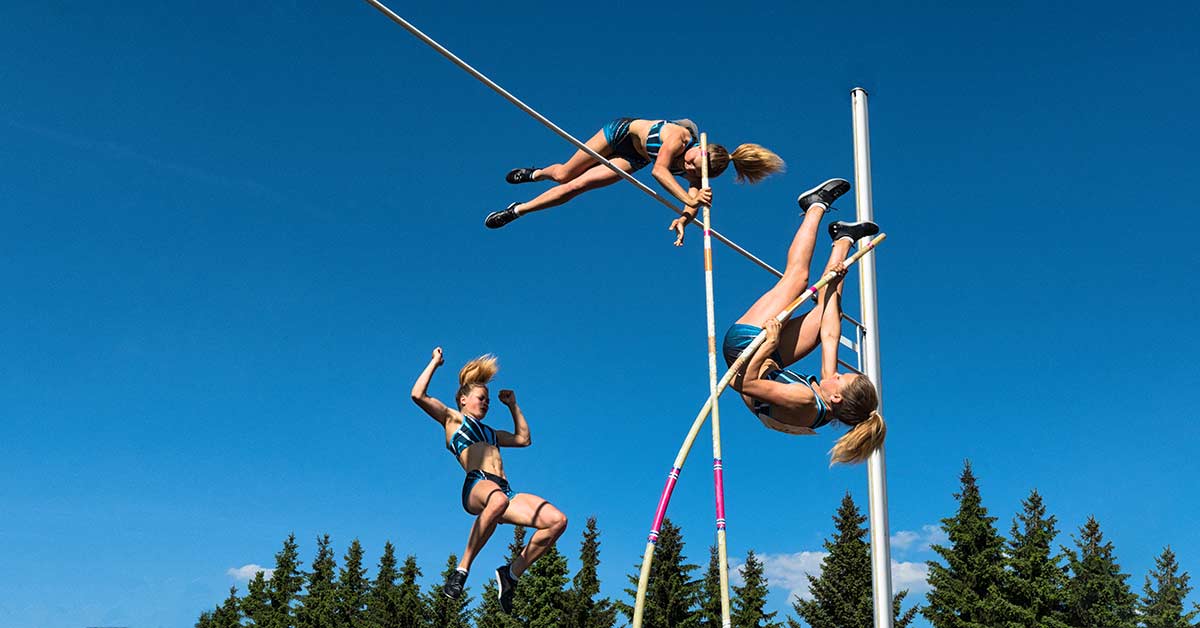Back to: PHYSICAL HEALTH EDUCATION JSS3
Welcome to class!
In today’s class, we will be talking about pole vault skills. Enjoy the class!
Pole Vault Skills

Track and field is a sport, which combines various athletic contests based on the skills of running, jumping, and throwing. The name is derived from the sport’s typical venue a stadium with an oval running track enclosing a grass field where the throwing and jumping events take place. Pole-vaulting is a track and field event in which a person uses a long, flexible pole, usually made of fibreglass or carbon fibre, as an aid to jump over a bar. The javelin throw is another track and field event where the javelin is thrown over a distance.
Pole vault event:
Pole vault is a track and field event in which the athlete jumps over a high bar with the aid of an extremely long flexible pole. Pole-vaulting became a competitive event in the first modern Olympic Games in 1896. In pole vaulting, the athlete sprints down a track, plant one end of the pole in the metal box, and catapult over the horizontal bar of about 4.5m in length, and then release the pole. The pole may be of any length or diameter and the pole is usually made either of fibreglass or carbon fibre. Pole jump competitions were known to the ancient Greeks, Cretans and Celts.
Pole vault skills
The skills involve Grip, Run-Up, Pole-carrying, Takeoff, Hang, Swing, pull-up and bar clearance, landing and Recovery.
- Grip: The pole is carried in the notch between the thumb and the index finger. The front arm should be held high and close to the chest with the wrist cocked back. The back arm-hand should be beside the hip pocket with the bow bent at 90 degrees. Also, the wider the hands, the easier it is to carry.
- Run-up: This is where the vaulter runs towards the plant box and the bar to gather momentum. The vaulter is expected to run with his body erect, and shoulders kept square and parallel to the bar.
- Pole Carrying: This skill is performed during the run-up. The body should be tall, and the pole should be carried as high as possible during the mid-portion of the run, letting it drop as the vaulter approaches the plant box. As the pole drops, the front hand becomes the bottom hand, but the position of the hands does not change.
- Takeoff: The takeoff foot is bent with the foot landing slightly in front of the hips on the takeoff stride. As the foot lands, the vaulter should start to rise. When the vaulter starts to leave the ground, the trail leg should be pushed hard against the runway. The position of the top hand is critical at takeoff and must be located directly over the foot at takeoff.
- Hang: During the hang, the shoulders are kept square and parallel to the bar. The body should stay long in full extension.
- Swing: When swinging, the body becomes a chord line of the arc formed by the flexed pole. Here, the body is made to go over the bar. At the stage, there is no full clearance.
- Pull-up and bar clearance: The pull is initiated with a straight fully extended top arm, which is pushed hard downward against the pole. During the pull, the bottom arm is collapsed into the body. At push-off from the pole, the thumbs should be pointed down. The push leads to the complete clearance of the bar.
- Landing: After clearing the bar with the pole pushed off, the vaulter makes air to surface descent on top of a huge mattress, which serves to create safety.
- Recovery: The vaulter picks himself or herself up from the mattress and makes for the bench.
In our next class, we will be talking about Swimming. We hope you enjoyed the class.
Should you have any further question, feel free to ask in the comment section below and trust us to respond as soon as possible.

I love the class
I love this class also
I love this class
Me too🙂🤩
i love the class
Glad you found it helpful😊 For even more class notes, engaging videos, and homework assistance, just download our Mobile App at https://play.google.com/store/apps/details?id=com.afrilearn. It’s packed with resources to help you succeed🌟
I really appreciated it to..
This was found helpful
I love this class
the techniques and skills are not complete they are 11 🚫 8
I find this helpful too but here are my questions:
What about.
1. pull-up and turn
2. push-up
Hi, please can I know the experience of pole vaulting . Make it a two page note